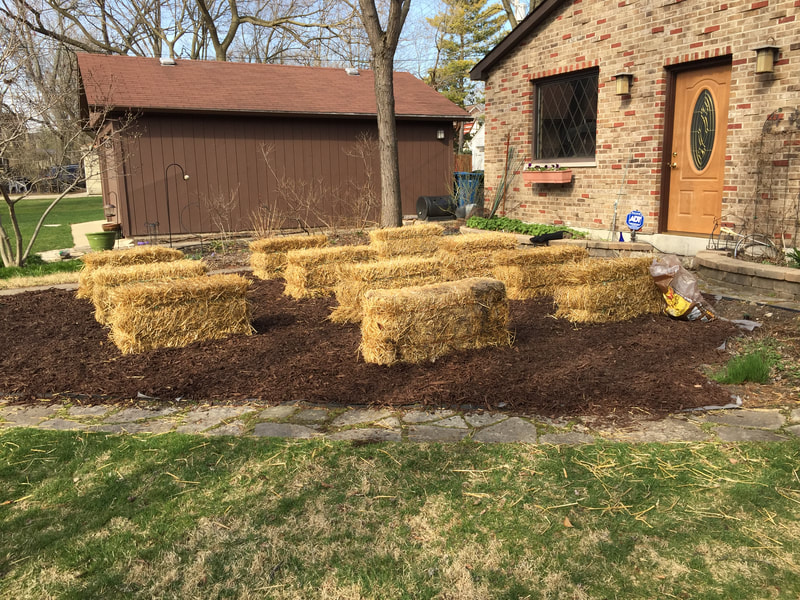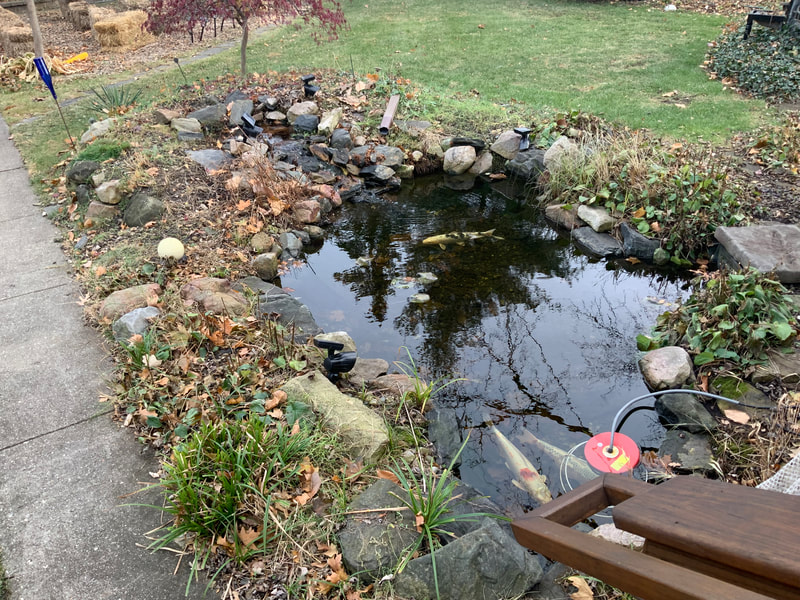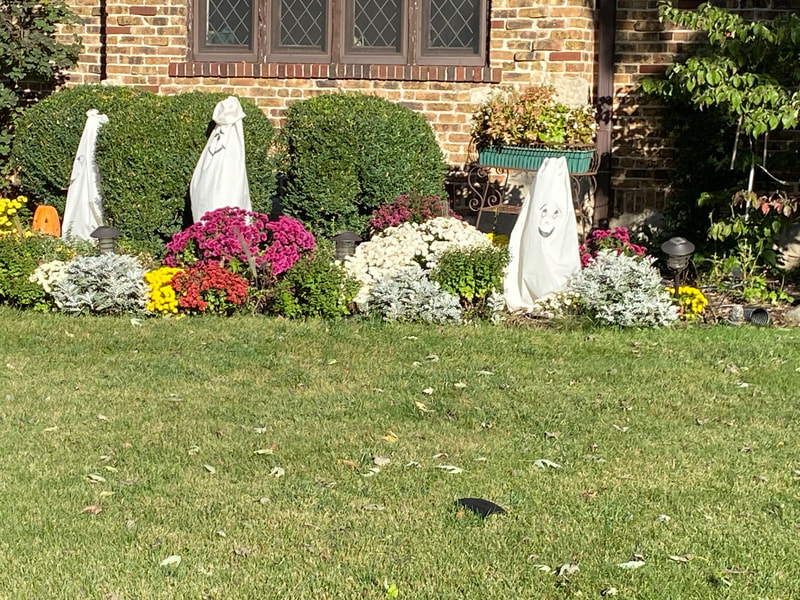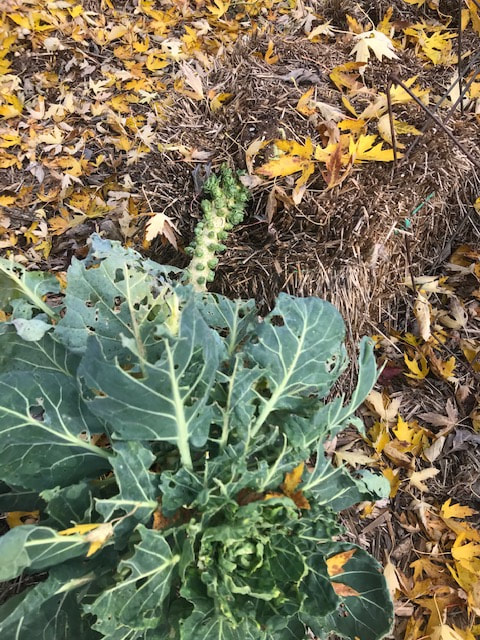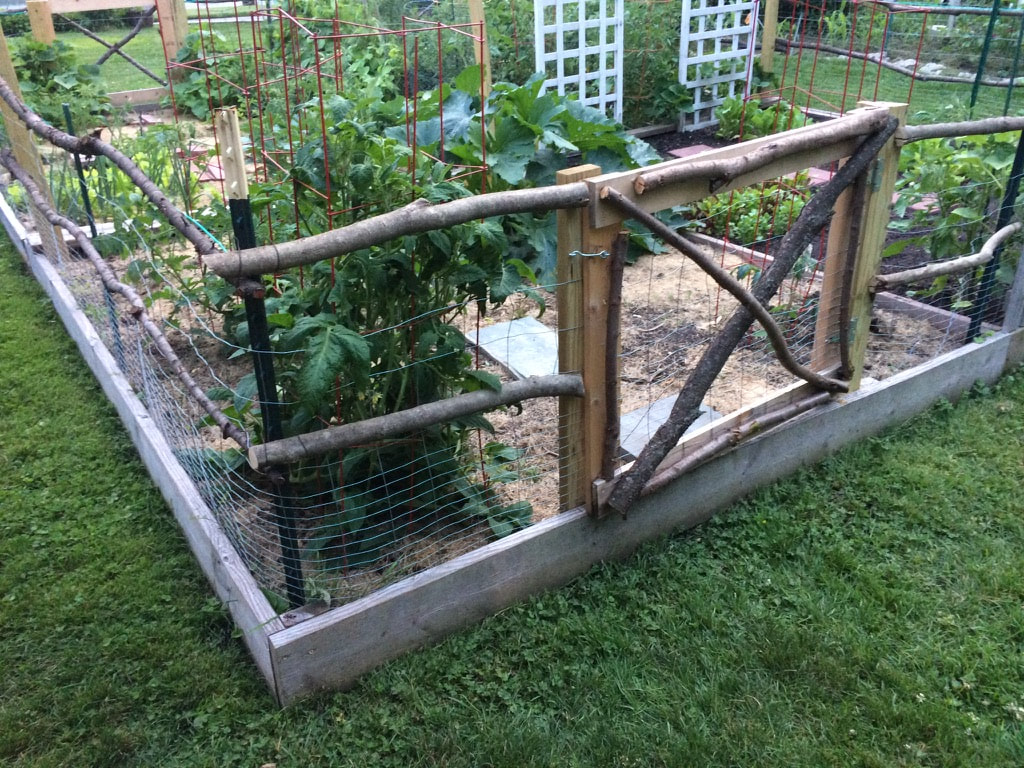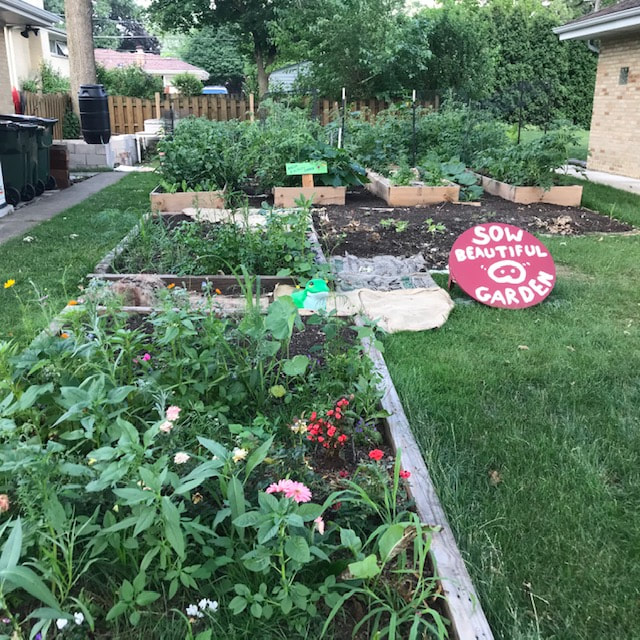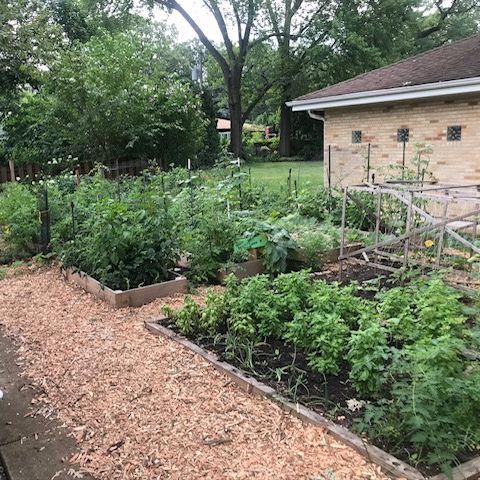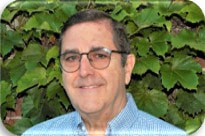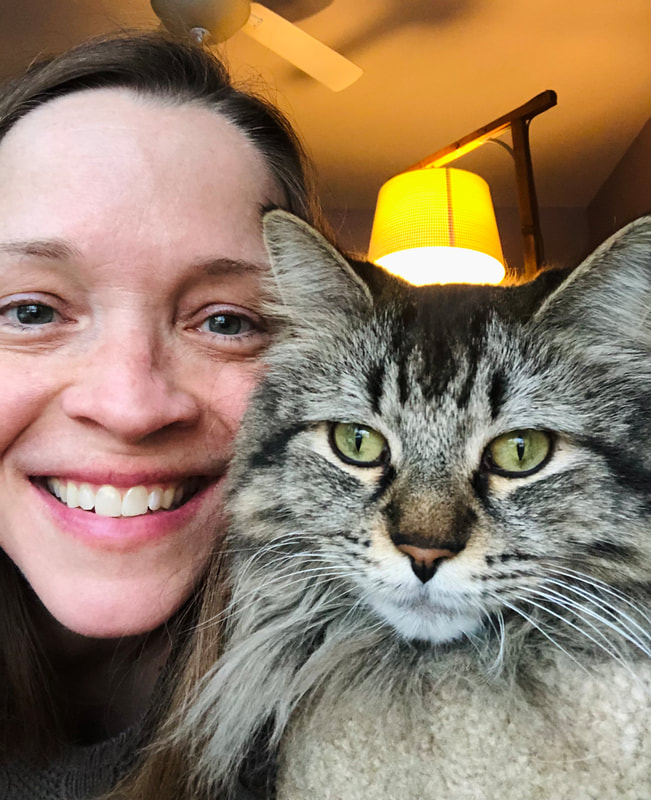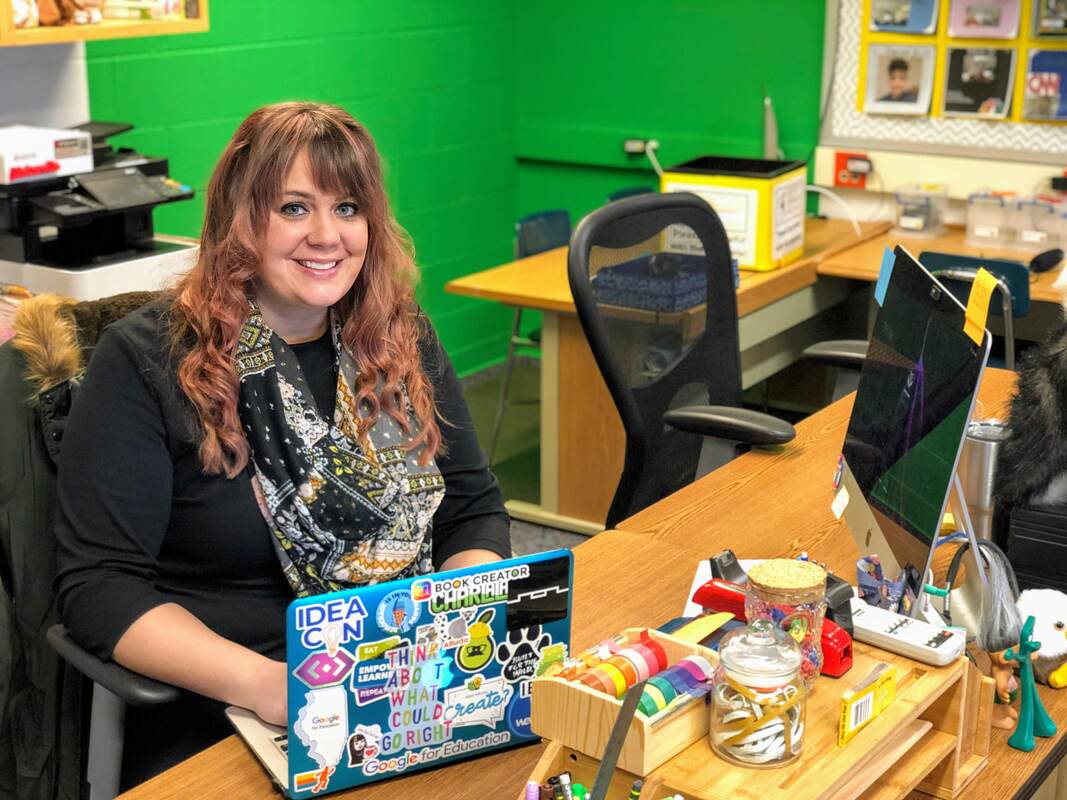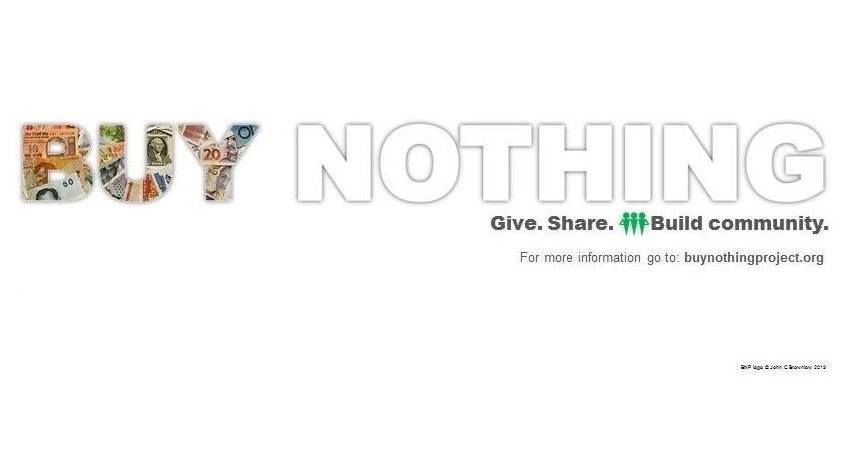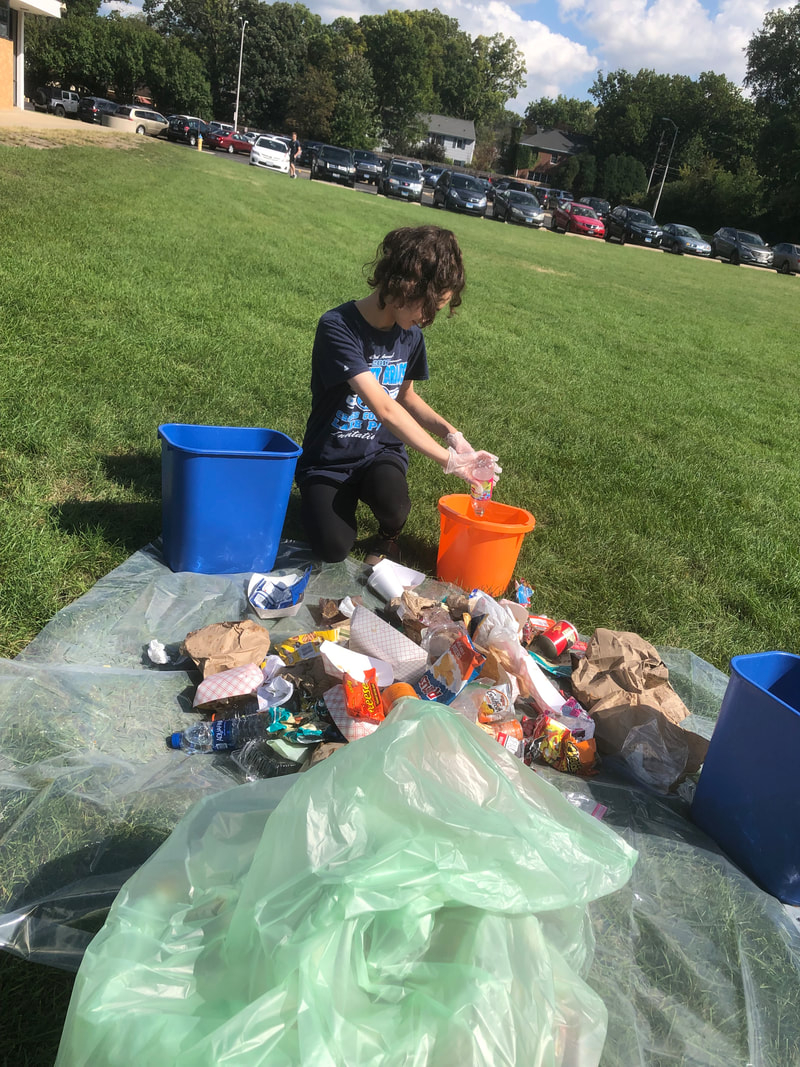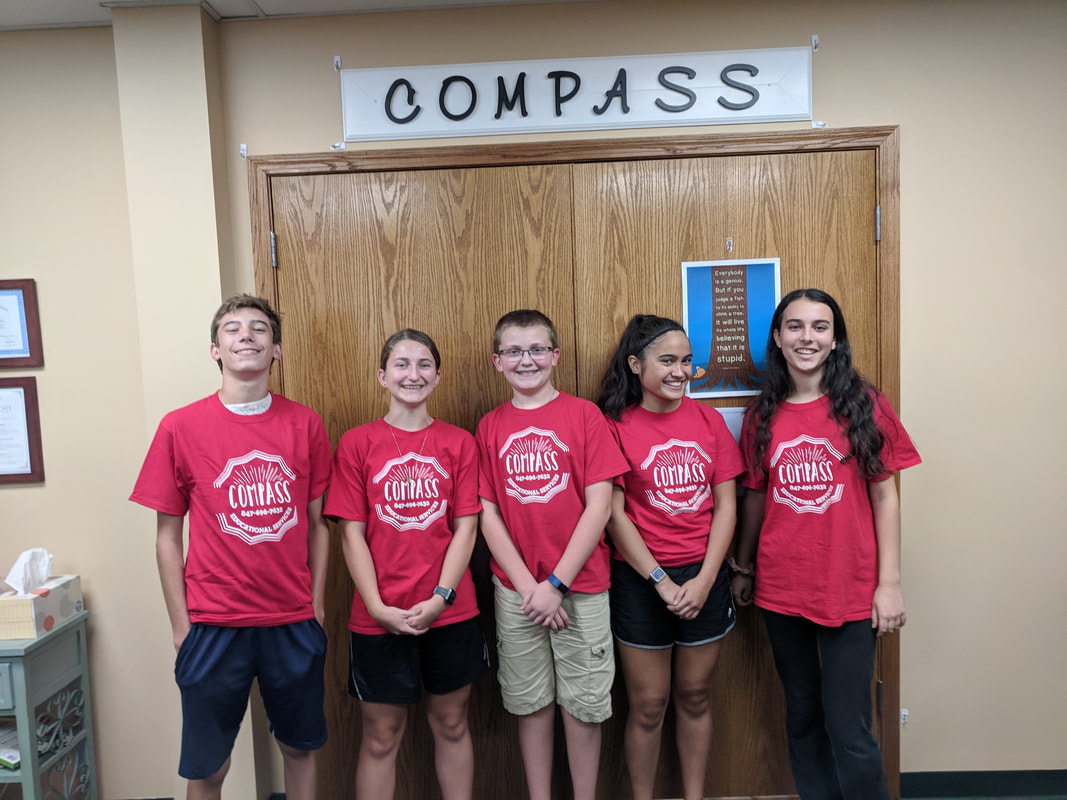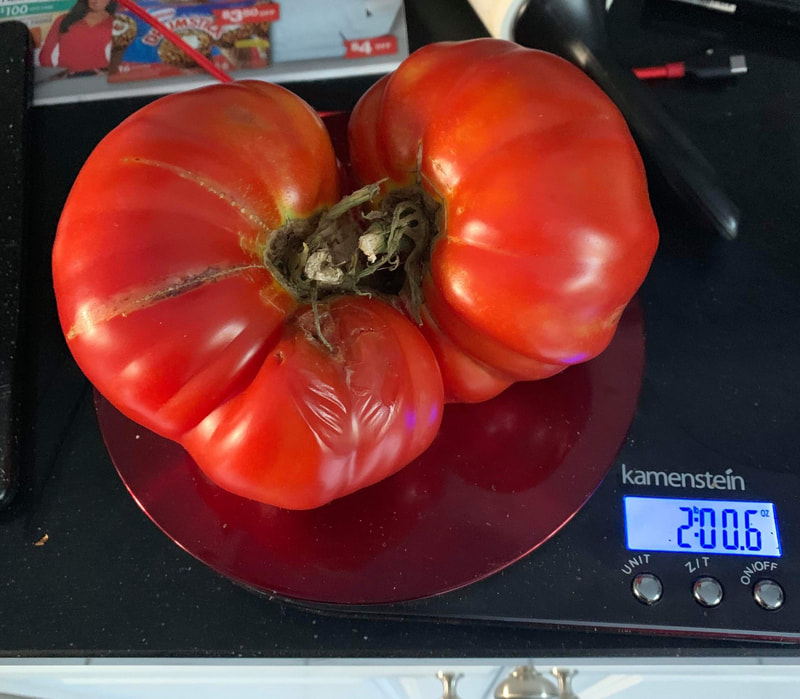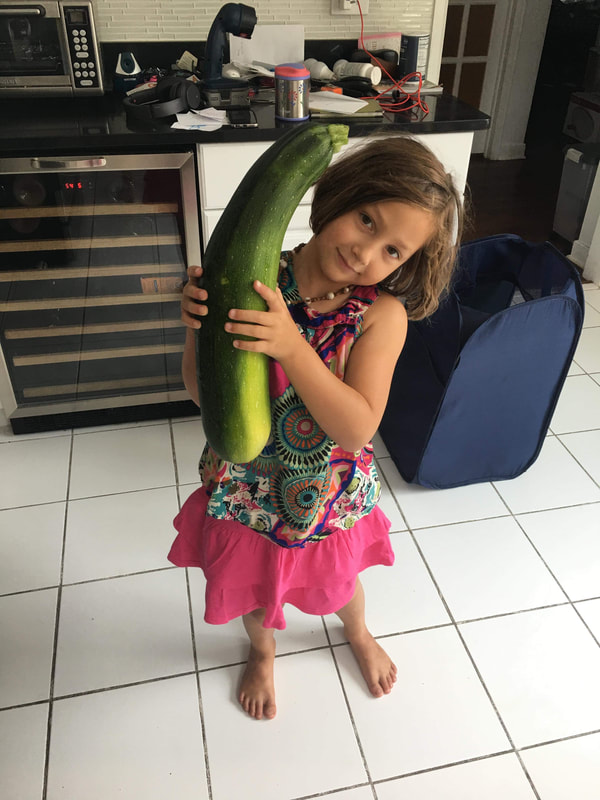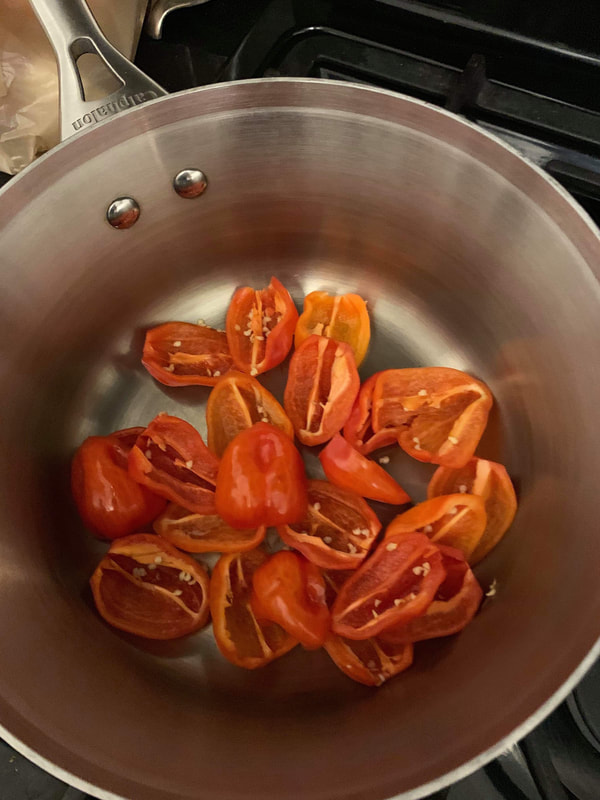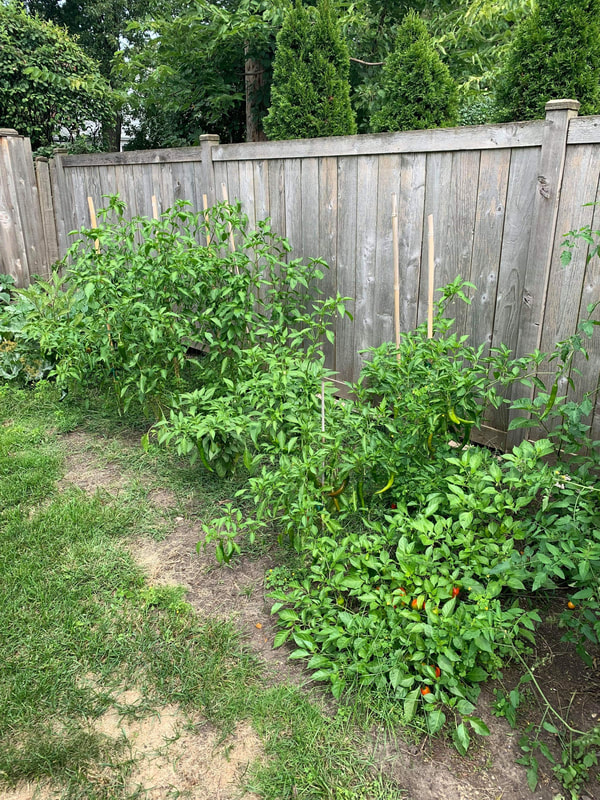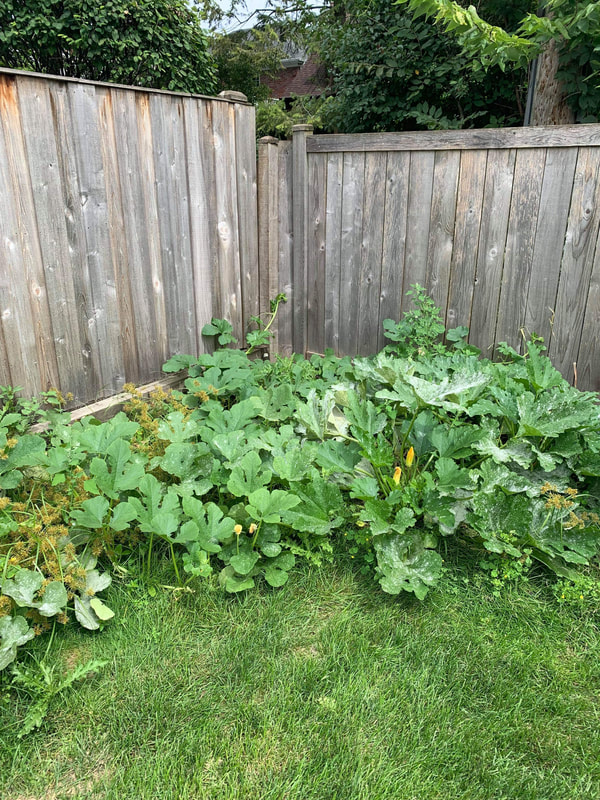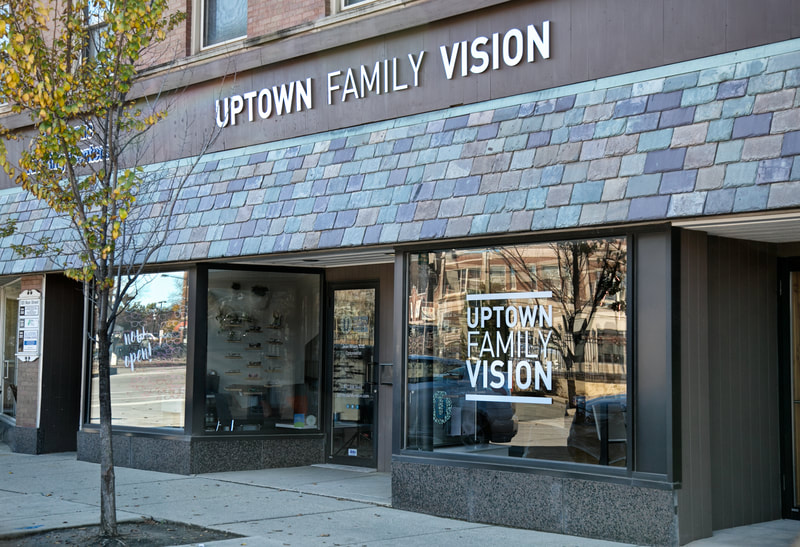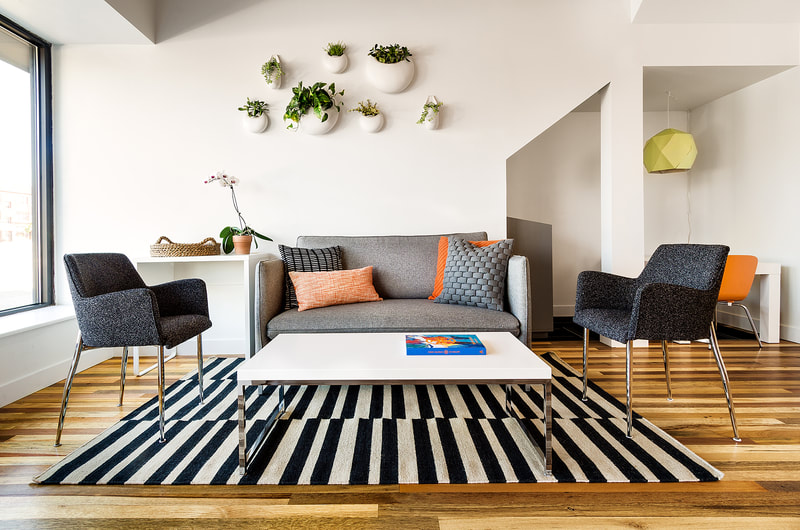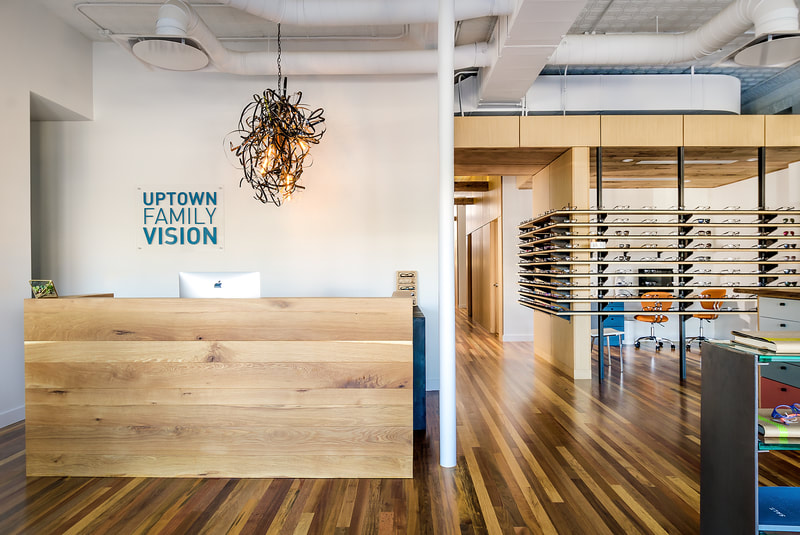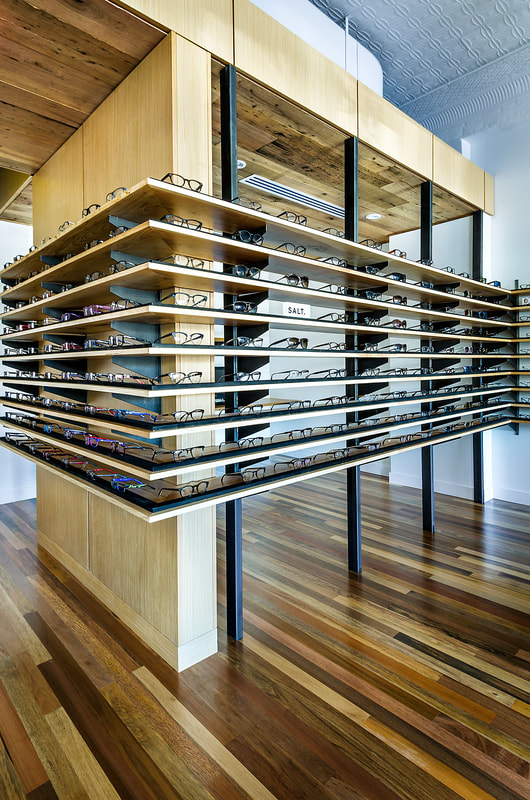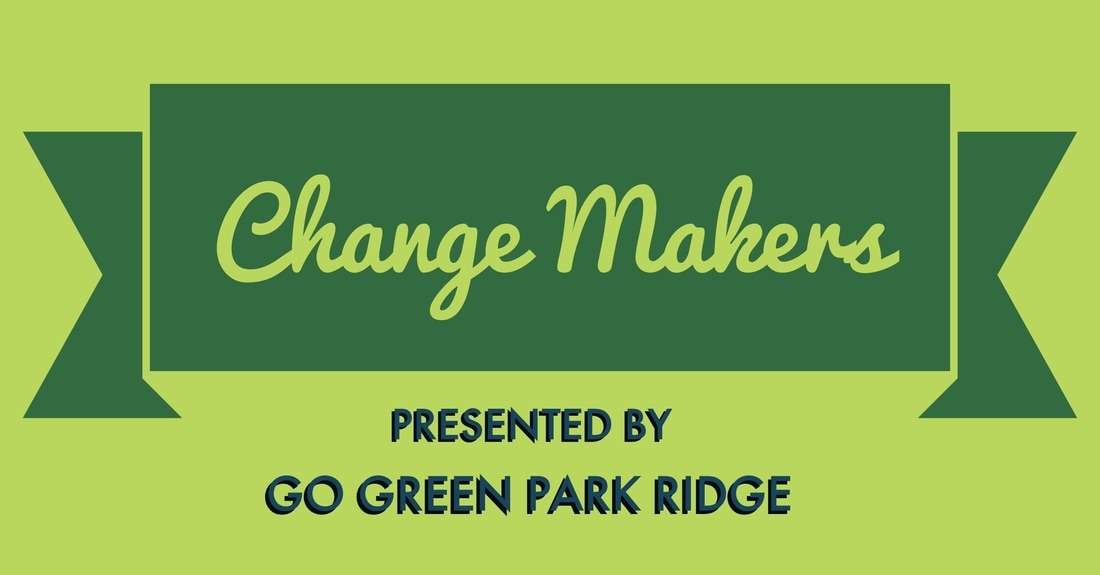|
I am Holly Gansz, a retired District 64 teacher. I garden and have been living in Park Ridge forever! I have been eco-friendly and green for many years. We recycle, reuse, and repurpose. I have used some large things, a wood burning stove, as garden art. But I would like to focus on three areas of my garden: 1) straw bale gardening, 2) dressing up my garden and 3) overhauling a garden.
Thank you for nominating me for the Changemaker recognition! Straw Bales This is a form of urban gardening. Bales can be placed anywhere, on patios, driveways, existing gardens, or grass. There is a science for treating the bales in the spring to prepare them for planting. It is a process of feed and water to start decomposition. Then you just place your seedling with a small scoop of soil and get ready to enjoy the harvest. Bales need very little water and then only to the top of the bale. (I watered twice in 2021). Our garden delivered eggplant, beans, kale, spinach, lettuce, red and green cabbage, green and wax beans, acorn butternut and mystery squash, tomatoes (finished my last tomato 12/7) rhubarb, zucchini, potatoes, onions and cukes. This is my second year using straw. I look around my neighborhood for homeowners with Halloween decoration using bales and invite them to let me recycle those straw bales. I have been very successful at gathering them free. I am hoping to reuse 9 bales and added seven new already. Dressing Up My Garden Although I plan to have something in bloom every day, sometimes my garden is not colorful. So to dress it up, I hang colorful pretty dresses in the trees and bushes. I have use a theme or I am spontaneous and fanciful with my choice of dresses. Maybe a wedding theme in ’22? I visit Goodwill, Salvation Army, or resale shops for deals. Several friends have contributed dresses. It’s just for fun and it’s interesting! Come by 909 S. Prospect (kitty corner from Roosevelt School) for a peek at the dresses next summer. Overhauling A Garden My large perennial area was looking shabby, weedy, and tired. In the process I read an article in the Trib about a plant rescue in an abandoned lot in Chicago using plastic grocery bags. In the fall, I dug up each plant, with a shovel of dirt to protect the root structure, placed it in a plastic sack, doubled the bag, moved the bagged plants to my vegetable garden and buried the bags for the winter. I had about fifty bags and only lost two. I cleaned up the old garden, rototilled, fertilized, and planned before winter took hold. Come spring, I dug up my sacks, replanted the flowers and enjoyed a well-earned colorful summer garden. I’m probably the only one to swipe bags from the Jewel recycle box! This was about 12 years ago, and I am thinking about a repeat. I did 2 other areas to complete restoring the beds. Other Go Green ideas 2L pop bottle greenhouses Reclaimed chair gardens Rain barrel Koi pond Planted 12 trees Mulching Soaker hoses Manufacturing dirt Composting
0 Comments
We had the idea of turning our yard into a community garden once our kids were grown and gone. Chris had the bright idea of creating a rain garden in a low spot, using the dirt from digging out our patio, to create a berm. And so, the Hodges Park Community Garden and Sustainable Yard began.
There are four 8 X 20 feet gardens, divided in half; so each gardener has a 8 X 10 plot. Chris and our first gardeners built fences out of buckthorn and chicken wire to keep bunnies, dogs and little children out of the gardens; and Chris built cute gates for each garden. The gardens are raised and filled with good soil and mushroom compost. Our own large in-ground garden is along our back fence. This year we’re going to plant “the three sisters” back there—corn in mounds, climbing beans around the corn and summer squash around the beans. Indigenous Peoples knew that “the three sisters” nurture each other and humans with all they and we need to survive. The corn gives us starch. The beans give us protein and the squashes give us nutrients to keep us healthy. By catching rainwater in our 4 rain barrels, creating a rain garden and building sedge rows we do our best to keep all of the rain that falls on our property out of the sewer pipes. We use no commercial pesticides or herbicides and have a large open compost bin for food and yard waste. Chris has a seed garden along our front hedge. He grows native plants that were given to him by the Forest Preserve. He collects the seeds from these plants each year. They are sorted and sent to various Forest Preserve sites to restore the woods and prairies to their pre-settlement glory. One of the most important results of all of these activities, especially the gardens in our yard, is the community building that happens. We have loved getting to know our neighbors better. It’s delightful to see them teaching their children to garden, seeing them chewing on a green bean, tomato or cucumber fresh from the garden. Of course, the main result of gardening is that we eat healthy, fresh food that we’ve grown ourselves. We hope that our small efforts to live sustainably and grow our own food will influence others to do the same. What started out as our own hobby has turned into a community effort that benefits more than just ourselves. We give and we receive. Thanks for recognizing us as “Changemakers”. It’s an honor. Nan and Chris Thank you for this honor, GGPR! Nan and Chris Parson (along with my environmentally conscious children) were our inspiration!
The choices we make today have a direct and immediate effect on the planet! A native plant landscape and community garden restores the soil, reduces pollution, attracts pollinators, creates beauty, grows tasty food, and enhances our personal and social lives. We are all stewards of the planet and if we, one by one, make better choices with our time and our land we can insure it will be here and be productive for future generations. We no longer use a gas or electric lawn mower. We no longer use pesticides or insecticides or put any toxic chemicals into the ground. Any materials we used were repurposed and thus diverted from a landfill. Our mulch and wood chips were all donated or sourced from ecologically responsible sources. We have met many fellow gardeners (and non-gardeners). We share ideas, plants, and food and drink with others. It has been a big positive for us physically, mentally, aesthetically and spiritually. We see and enjoy the fruit of our labor and native plants let the planet heal itself. We are constantly learning and trying new things too. Most of all it has been fun to do! Covid-19 slowed down our Community Garden plan in 2020. We had twelve raised beds and attracted three neighbors to join us. There will be more people involved this year. Even the act of starting the garden last year led to meeting others and starting friendships. Thank you, GGPR. Sue & Mike Do you see important connections with the role you play in our community and our future on this planet?
Tim: I have studied the relationships between collective and individual actions at local, state, federal and global levels related to climate mitigation and adaptation needs, and how change unfolds. What I have learned is action is needed at all levels and every action can make a difference. I have been active locally and at the State level, focusing on energy and transportation sustainability and can tangibly see positive changes. It boils down to understanding the technical, political, social and economic issues and helping as one can with one’s voice, vote and wallet to help – no matter the size or type of the contribution. We are in this together. Melissa: Yes. So many decisions that impact the environment and greenhouse gas emissions are made at the local level—most notably, decisions regarding transportation and land use. Local governments and organizations also have an important role to play to communicate with people about how their day-to-day actions affect the environment and the easy ways they can lessen their impact. Given that change at the federal level can be slow and frustrating, it’s been really rewarding to see my efforts help drive positive change in a relatively short period of time. GGPR: Do you see important connections with the role you play in our community and our future on this planet?
Ms Corsello: As a technology elective teacher at Emerson Middle School, I teach over 400 6th, 7th, and 8th graders a year. In two of my classes, Multimedia Magic and Broadcasting, students are able to choose from a variety of short video project assignments. I’ve found great value in providing my students with an authentic audience by publishing their video projects on my teacher YouTube channel, https://youtube.com/MsCorsello. Many of the videos also make it onto our live video announcements, which airs on Fridays during homeroom. My goal is to engage and empower learners by providing student choice (see the learning menu and choice board linked above). One of the projects that students can choose to create is an environmental public service announcement. There are over 30 videos ranging from recycling misconceptions to deforestation in the Environmental PSA playlist. These videos serve as a tool to inform the community about environmental issues and persuade them to take action. My students and I have teamed up with Go Green Park Ridge to spread the word about various initiatives. In the spring 2019, Amy Bartucci visited my classroom to inform us about GGPR’s Straws Literally Upon Request Policy (#SLURP) initiative. Students worked in groups to create promotional videos to be shown during D64’s Go Green Week April 15-19th. In the fall, a broadcasting class news team filmed an interview with GGPR’s mother and daughter team, Catherine and Annie McDonough, in our digital media lab on the essential question, “What impact would a ban on plastic straws have on the ecosystem?”. We look forward to continuing our relationship with GGPR - when we work together we can have a greater impact! Go Green Park Ridge YouTube Videos GGPR: Do you see important connections with the role you play in our community and our future on this planet?
Reese: I am so excited to share information about the Buy Nothing Project Park Ridge (South). The Buy Nothing Project is a grass-roots-volunteer driven project started by two Washington State residents in July 2013 and has reached over 30 nations. The rules of the Facebook-based group are simple, “Post anything you’d like to give away, lend, or share amongst neighbors. Ask for anything you’d like to receive for free or borrow. Keep it legal. Keep it civil. No buying or selling, no trades or bartering, we’re strictly a gift economy.” I am so fortunate to be the administrator for the Buy Nothing Project Park Ridge (South). By leading this group, I’m hoping to encourage community, recycling/repurposing, and rethinking the need to buy new. I want to facilitate the building of close friendships in the small neighborhood of the Buy Nothing community. The type of neighbor friendship where you would go knock on the door if you need an egg to make the cake you already started. I believe we will see two major outcomes of this group: 1. A cleaner planet because we are reusing, recycling and reducing our waste and members are more aware of creating a greener community. 2. A stronger community and friendship among neighbors in a small local area who will continue to support the mission of the Buy Nothing Project. The Buy Nothing Project creates small hyperlocal gift giving economies and so Park Ridge is split into two different groups, North and South. The boundaries of the South group are Busse Hwy and Touhy Ave on the North, Canfield Ave and S Merrill St on the East, Higgins on the south and Des Plaines River and North Talcott on the west. Currently, there is still opportunity for someone to create and administer a Buy Nothing Project Park Ridge (North) group! If you are interested, please see more information about the project at the website below! You will also find a button to link you to Facebook if interested in the South group. Maine South Senior, Catherine Vittallo: December ChangeMaker and Go Green Park Ridge intern12/15/2019 "We learned a lot from this waste audit. Over two bins of recycling were placed in the trash with remaining liquid as well as a lot of other food which was wasted." Hi, my name is Catherine Vittallo. I’ve been working with SWANCC (Solid Waste Association of North Cook County), Go Green Park Ridge, as well as the environmental club at my high school to make the cafeteria specifically more environmentally friendly. We are starting with the huge recycling issue ... it’s nonexistent. A couple long term goals are to save electricity in vending machines, reduce plastic use, as well as implement more water filtrations in the school.
I've also been trying to promote the use of ecosia more - the search engine that plants trees. It's basically the same as google except that they use their profit to plant trees where they are needed the most. Specifically to make steps for a greener cafeteria, Mrs. Lauren Maloney and I applied for a SWANCC grant to implement recycling stations into the cafeteria. This way, students are forced to have a choice of where to put their trash; recycling, landfill, or compost. Currently, their only option is the trash and that's not ok. Additionally, I've also met with Dr. Collins and Mr. Berendt at my school about putting up posters around the school and in classes above recycling on what should and shouldn't be recycled. The problem is most people still don't know what to recycle. Implementing signs would be extremely helpful so that the trash is correctly sorted right away. One last thing Dr. Collins and I are working on is saving electricity. Starting small with the vending machines, but working towards hiring a dedicated person to turn everything off at the end of the night. This would not only save the school a ton of money but save a lot of electricity at the same time. A future goal of mine is to use social media such as facebook and instagram to share current events about the environment. Most people don't understand the little things that they can do to make a difference. Even at the end of my internship if only a couple more people know small alterations they can make to their everyday routines to better the planet, I would be extremely happy. Her students learn how to learn, so they can succeed in school and life!
GGPR: Do you see important connections with the role you play in our community and our future on this planet? Laura: Yes! Compass has purchased a Cupanion bottle with a Fill It Forward bar code and a green T-Shirt for our clients to show our support for going green. Each time our students fill up the water bottle the student scans the barcode on top of the bottle and then gets feedback on what water project is currently in progress. We believe the less paper and plastic cup waste we produce will help lower our environmental footprint on the earth. The Cupanion,Fill It Forward, partnership allows our students to make a difference in the lives of individuals that do not have access to clean water and it also lets our students see how much they are saving in carbon emissions. Recently, we have also begun recycling paper by putting bins around the office. Each week we empty the bins and take the recyclables home. This way we are saving paper from contamination and increasing its recyclability. GGPR: Do you see important connections with the role you play in our community and our future on this planet? Would you like others in our community to know more about your efforts?
Heidi: Absolutely! I created the Facebook group this past April because we are gardening enthusiasts and wanted to connect with other local enthusiasts and focus a bit more on fruit/vegetable gardens. We always start our plants from seed, but we plant more than we need to make sure our seedlings survive. Once we know we have what we need we like to give away our other seedlings instead of them just going to waste. Once the garden gets started we usually have too much produce and again would rather share than go to waste. There was a much larger interest in the Facebook group than I originally thought. We do have a lot of members, but I would like to see more posts and definitely more sharing of ideas, plants and produce. It’s still new so hopefully it’ll grow in that direction! GGPR: Do you see important connections with the role you play in our community and our future on this planet? Would you like others in our community to know more about your efforts? Dr Nham: As a part of our local community, we absolutely feel that we have a certain level of responsibility to make efforts to protect our environment. As a small business, we may not be able to make a huge impact, but we hope we can set an example that will encourage others to make small steps towards becoming more eco-friendly. Some of the steps we've taken in our office are:
|
Park Ridge:Take a look at what your neighbors are doing for Park Ridge sustainability! |

